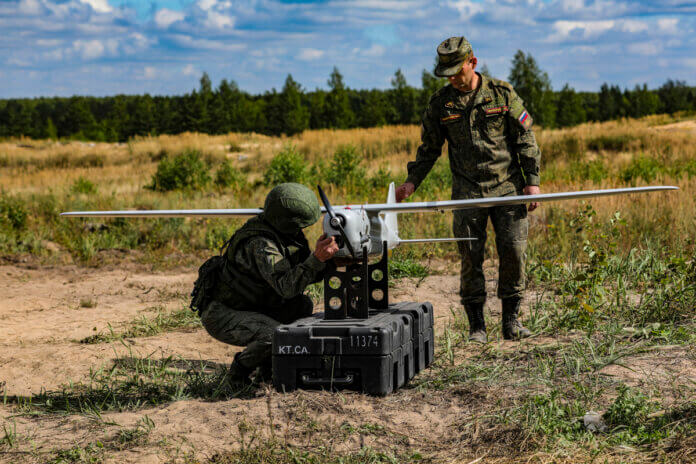
New information on the Russian Army’s Orlan-10 UAVs’ vulnerability to electronic warfare has come to light.
Sources involved with Ukrainian Uninhabited Aerial Vehicle (UAV) operations told Armada that the Russian Army’s Orlan-10 UAVs tend to use frequencies of 930 megahertz/MHz. Radio transmissions on this frequency links the UAV to its operators on the ground.
The source continued that Orlan-10 UAVs typically deploy in three-ship formations. One ‘master’ aircraft uses the 930MHz radio link to connect with the pilot on the ground. The other two ‘servant’ aircraft each carry a mission payload and are linked by radio to the master. Commands from the pilot to these two UAVs are relayed by the master aircraft.
The master UAV typically flies above the two servant aircraft placing it beyond the reach of short-range air defence systems like the Raytheon FIM-92 Stinger missiles the US has supplied to Ukraine. Open sources say this weapon has a range of up to 2.6 nautical miles (4.8 kilometres). Its maximum engagement altitude is reportedly 12.467 feet/ft (3,800 metres/m). The Orlan-10 has a maximum altitude of 16,000ft (5,000m) according to open sources.
Concept of Operations
The source added that the two servant UAVs each carry distinct payloads. One is equipped with an optronics payload to visually hunt targets for Russian artillery. The other carries a Communications Intelligence (COMINT) payload.
Orlan-10 aircraft form part of the Russian Army’s RB-314V Leer-3 electronic warfare system. As previously profiled by Armada, the Leer-3 is deployed with Russian Army EW brigades. One system equips each brigade which provides operational-level electronic warfare to the army. The Leer-3 is believed capable of detecting and jamming signals across a 30 megahertz to three gigahertz waveband. The system detects and jams cellphone traffic, and can infect that traffic with fake text messages.
The source said that Orlan-10 aircraft configured for COMINT prioritise the detection of transmissions from Baofeng civilian handheld radios. These typically transmit in very/ultra-high frequencies of 30MHz to three gigahertz, squarely within the Orlan-10’s remit. Although Russia’s use of Baofeng radios was documented at the start of the conflict, they may also be used by Ukrainian troops. Given the Orlan-10’s competence, the latter would be strongly advised to reduce dependency on these radios.
The imagery intelligence and SIGINT is transmitted to the master aircraft which sends it to the operator on the ground. This information is correlated and target coordinates are sent to Russian Army artillery. The source said that “rounds are delivered within ten minutes of targets being identified by a three-ship (Orlan-10) flight”.
Vulnerabilities
The good news is that these Orlan-10 formations are not invulnerable. The 930MHz link connecting the master aircraft with the pilot on the ground is vulnerable to jamming. Global Navigation Satellite System (GNSS) 1.1GHz to 1.6GHz signals are also vulnerable to attack. A holistic approach to engaging these aircraft hold promise. An Electronic Support Measure (ESM) can passively detect the 930MHz link and GNSS signals. These signals can be jammed and at least one of the three-ship formation attacked kinetically.

“If one payload UAV is taken down, the entire fleet returns to base,” the source advised. From a force economy perspective, this is handy for the Ukrainians. Destroying one aircraft takes all three out of the fight. If the ESM can locate the UAV pilot’s position it may be possible to kill them with artillery.
If Ukraine is to defeat Russia’s invasion and occupation, she must fight imaginatively and asymmetrically. Russian Army UAV pilots, ground control systems and aircraft will be finite resources, becoming scarcer as sanctions against Russia tighten the supply of foreign components needed for her materiel. Our Western Bits in Russian Kit article explains Russia’s dependence on western electronics. This is particularly apparent in Russian communications and EW systems. As the articles show, the Orlan-10 also relies on western components. Killing as many UAV pilots as possible should help damage morale, dissuading other soldiers from taking up this career.
by Dr. Thomas Withington












